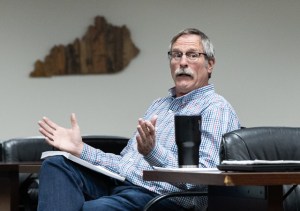City to partner with WKU to pinpoint suds origin
Published 8:30 am Saturday, July 30, 2022

- Suds surround Lost River Cave’s tour boat at approximately 10 p.m. on Wednesday, July 27. The recurring soapy issue has gotten worse in the last six months, Lansden said.
The city of Bowling Green plans to conduct a more “exhaustive and precise” groundwater study with Western Kentucky University as suds incidents escalate at Lost River Cave, according to Matt Powell, Bowling Green Public Works environmental manager.
The study, which has not started and remains in its design and funding stages, aims to “provide a much deeper understanding of the nature of the issue and potential sources,” Powell said.
Trending
The soap suds have long been a subject of investigation, but when they began appearing without a prior rainfall, it was clear that something more needed to be done, Powell said.
The city has previously conducted tests at Lost River Cave to determine whether the suds were caused by surfactants, compounds that make up soap. The results were positive, but the tests didn’t reveal much else useful information, Powell said.
The WKU study will focus on obtaining more specific and helpful data by getting a gradient of the groundwater, which will more accurately pinpoint which areas have higher concentrations of chemicals.
It is also expensive, and the city is currently working to find regulatory partners to help fund and implement it.
Powell said it is “very unlikely” that household quantities of surfactants could produce the volume and consistency of suds Lost River Cave is experiencing. The culprit is likely one or more industries in the watershed.
Powell declined to identify which industries his department is investigating, but said that of the inspections they have completed so far, “we have not found a conclusive source.”
Trending
Surfactants and optical brighteners are commonly used by detergent, textile and paper industries to clean and/or whiten products, and may be utilized by paint, plastic and cosmetic industries to a lesser extent.
The Environmental Protection Agency regulates chemical waste through the Resource Conservation and Recovery Act. Waste that might be harmful to the environment or human health cannot be disposed of in regular trash or via the sewer system. It must be recycled, treated or disposed of in alternative, safer ways.
“The city of Bowling Green considers the intermittent presence of soap in the water at Lost River Cave to be an illicit discharge under our ordinances,” Powell said.
When Bowling Green Public Works conducts site visits, it checks if chemical disposal meets the mark. Powell said they ask industries which chemicals they are using, where they are using them and how they know their system is a “closed-loop system” with no cracks.
Powell is not sure when the WKU study will begin, but in the meantime, Bowling Green residents should not worry about their water supply, said Mike Gardner, Bowling Green Municipal Utilities water and wastewater systems manager.
When asked if the suds flowing from Lost River Cave to Jennings Creek to Barren River would hurt BGMU’s water quality, Gardner said “the very short answer is no.”
BGMU’s water intakes are upstream of the Jennings Creek-Barren River merging point, meaning its supply of water is taken out before it could be affected.
Gardner added that as far as he knows, there are no other intakes for public water supply before Barren River meets the Green River, at which point any contaminants would be diluted enough to not cause concern.







